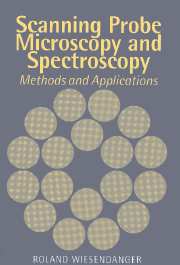Book contents
- Frontmatter
- Contents
- Preface
- List of acronyms
- Introduction
- Part one Experimental methods and theoretical background of scanning probe microscopy and spectroscopy
- 1 Scanning tunneling microscopy (STM)
- 2 Scanning force microscopy (SFM)
- 3 Related scanning probe methods
- Part two Applications of scanning probe microscopy and spectroscopy
- References
- Index
1 - Scanning tunneling microscopy (STM)
Published online by Cambridge University Press: 05 October 2010
- Frontmatter
- Contents
- Preface
- List of acronyms
- Introduction
- Part one Experimental methods and theoretical background of scanning probe microscopy and spectroscopy
- 1 Scanning tunneling microscopy (STM)
- 2 Scanning force microscopy (SFM)
- 3 Related scanning probe methods
- Part two Applications of scanning probe microscopy and spectroscopy
- References
- Index
Summary
Before we focus on the different modes of operation of a scanning tunneling microscope (STM) and the information which can be extracted, a historical review of earlier studies of tunneling phenomena is given in the following sections. This will serve as an introduction to tunneling experiments as well as motivation for a variety of experimental methods applied in STM. It will become clear later in this chapter that most of the special effects now studied in STM have already been investigated before by using planar metal–oxide–metal tunnel junctions.
Historical remarks on electron tunneling
Tunneling is an important mechanism of transport in condensed matter and across artificial junctions. In contrast to other transport mechanisms such as diffusion and drift, which can be described on the basis of classical physics, tunneling can only be understood in terms of quantum theory.
Consider a potential energy barrier and a microscopic particle, e.g. an electron, with an energy smaller than the potential barrier height. From the viewpoint of classical physics, this particle will never be able to traverse this barrier. However, in quantum theory, the wave–particle dualism may in fact allow this electron to traverse the barrier. The wave nature of microscopic particles (de Broglie, 1923) impinging upon a potential energy barrier is expressed in the experimental observation of a finite probability of finding the particles beyond the barrier and they are then said to have tunneled through it.
- Type
- Chapter
- Information
- Scanning Probe Microscopy and SpectroscopyMethods and Applications, pp. 11 - 209Publisher: Cambridge University PressPrint publication year: 1994
- 3
- Cited by

